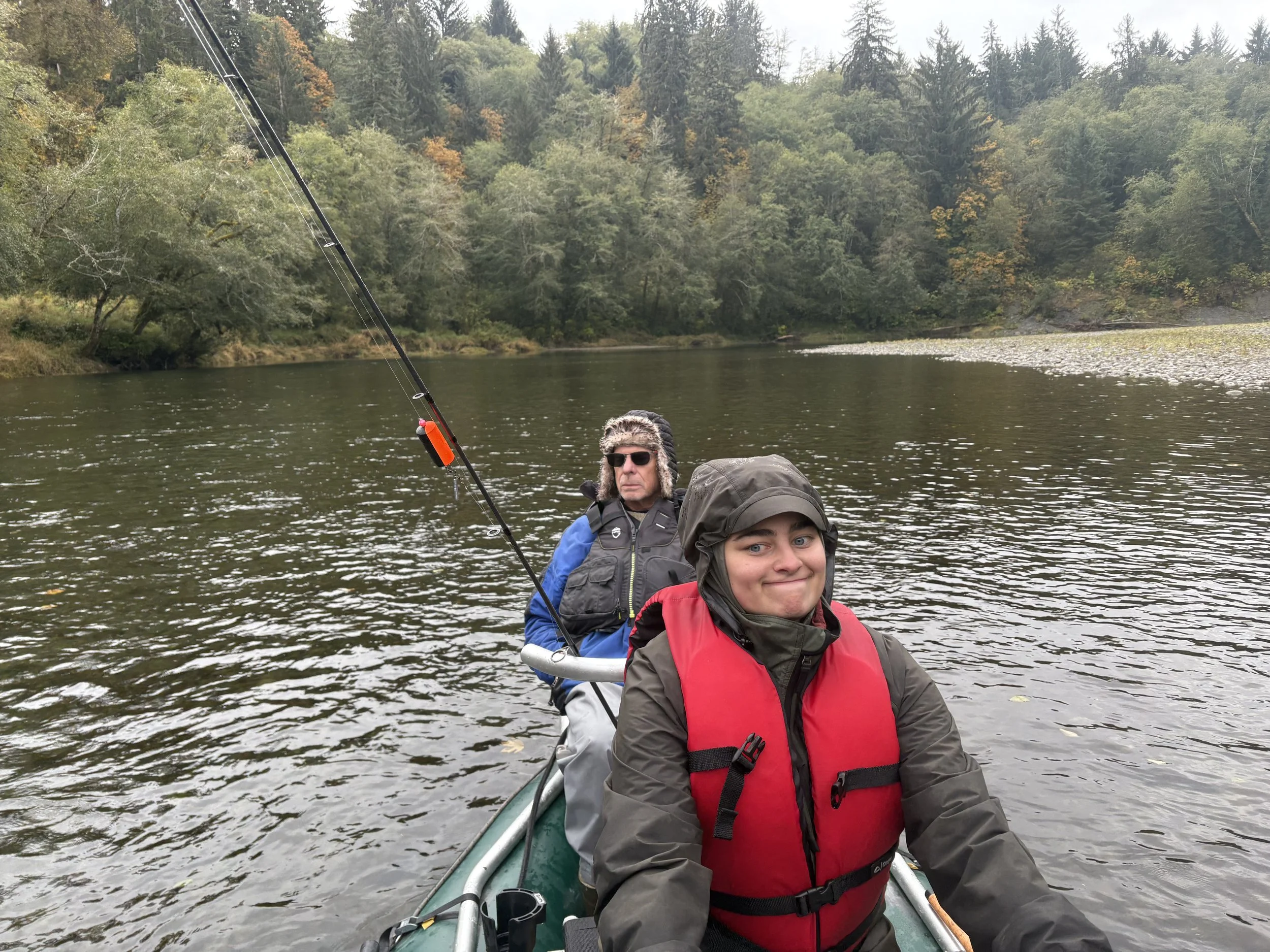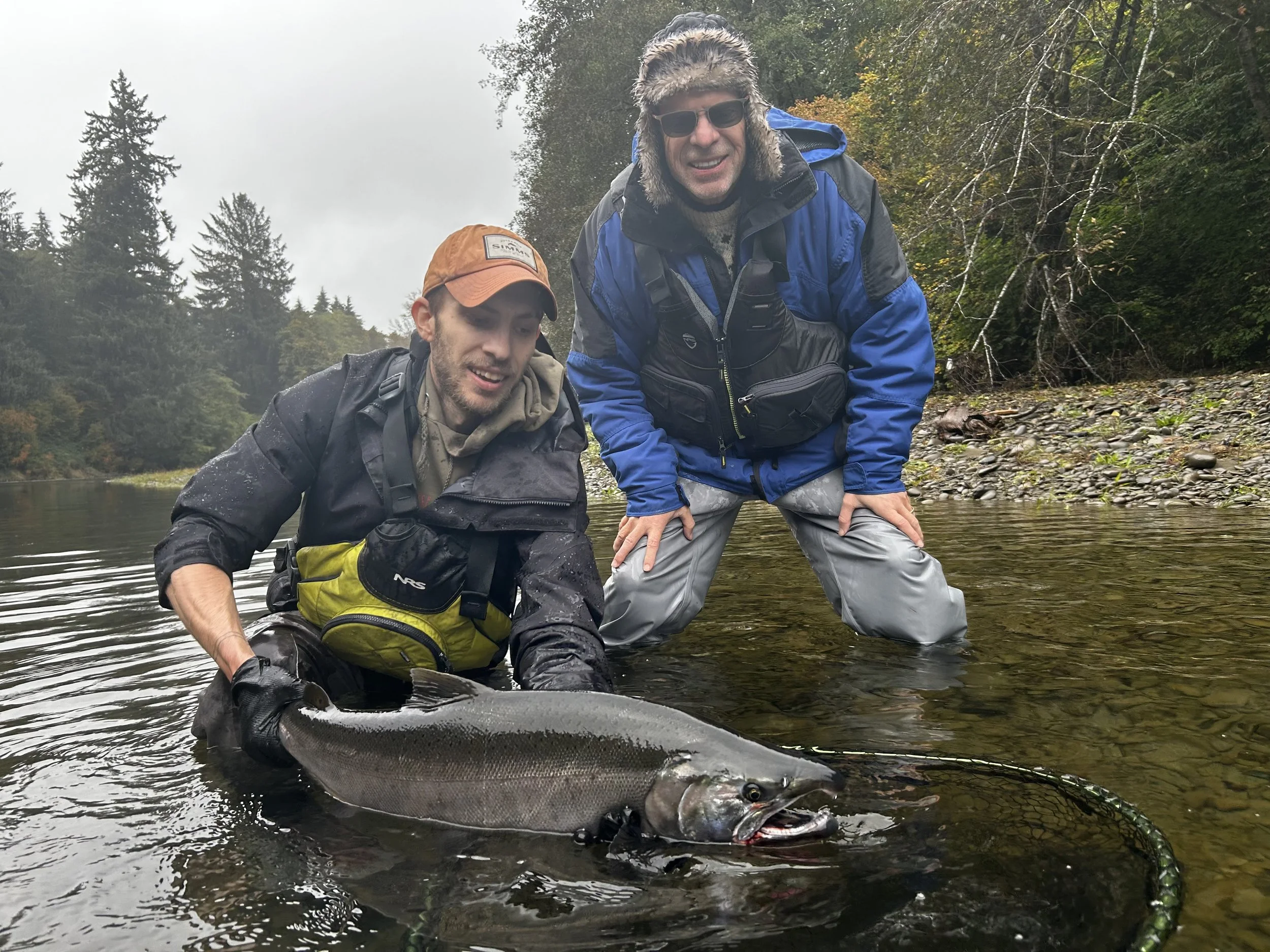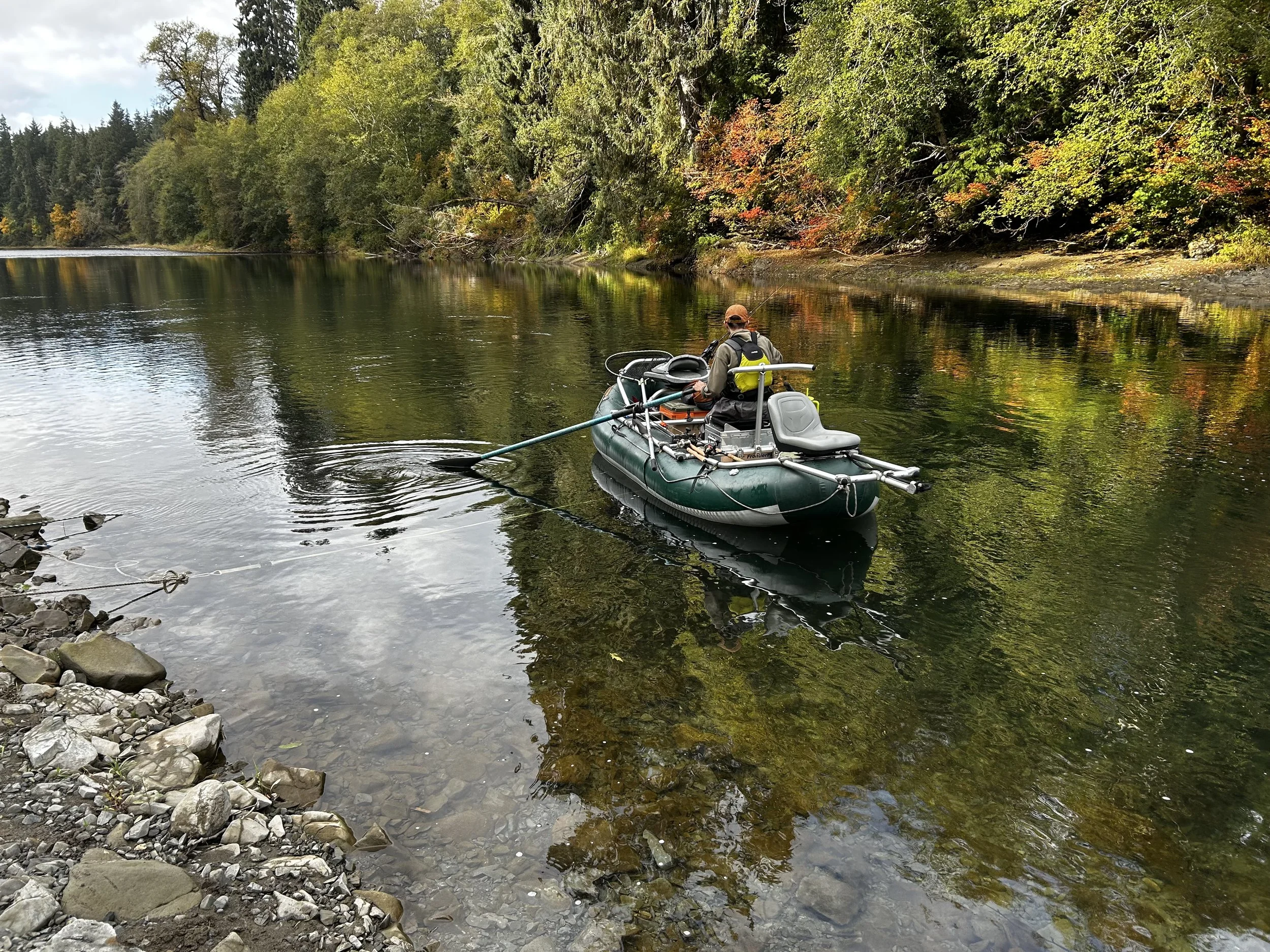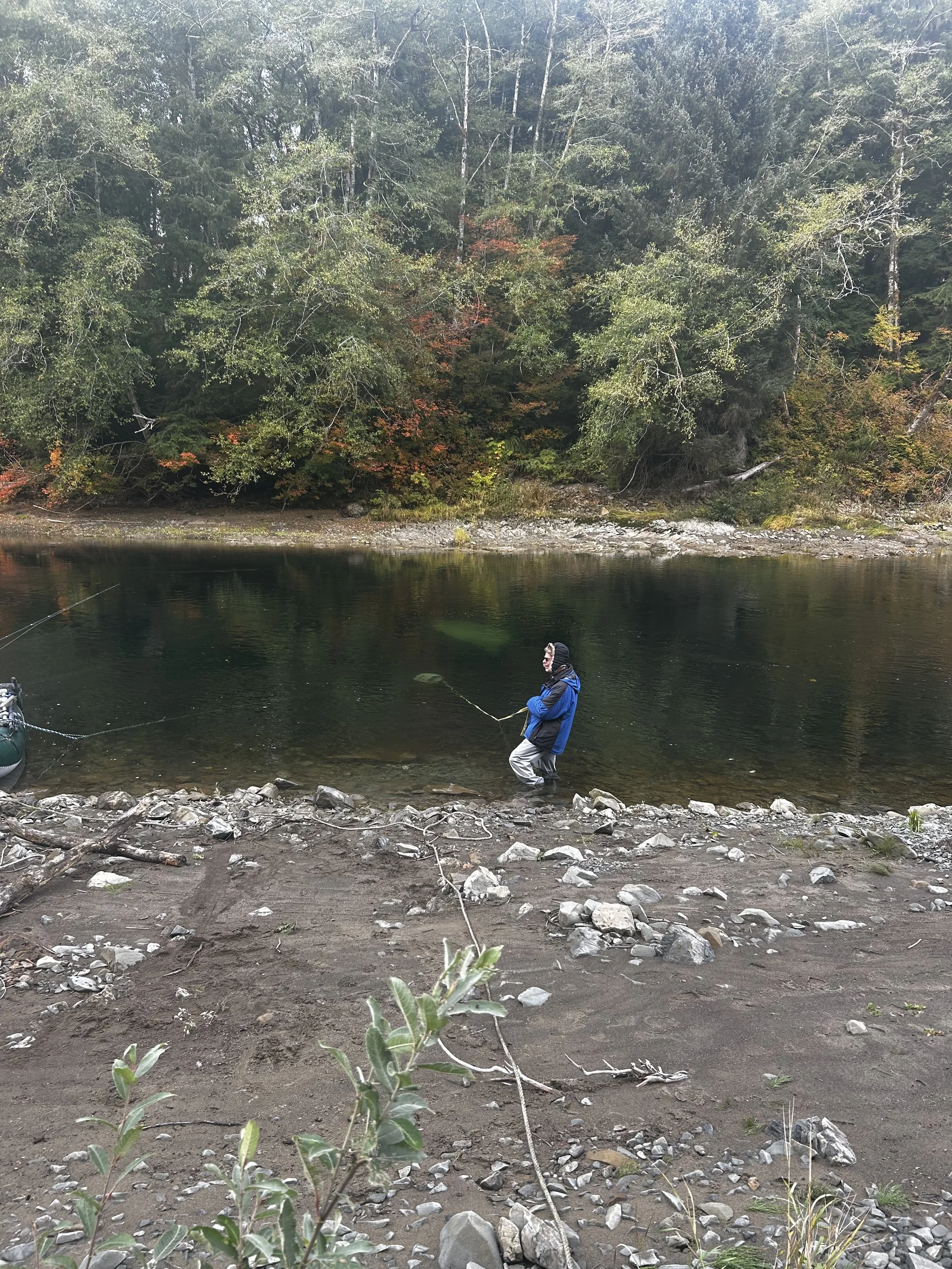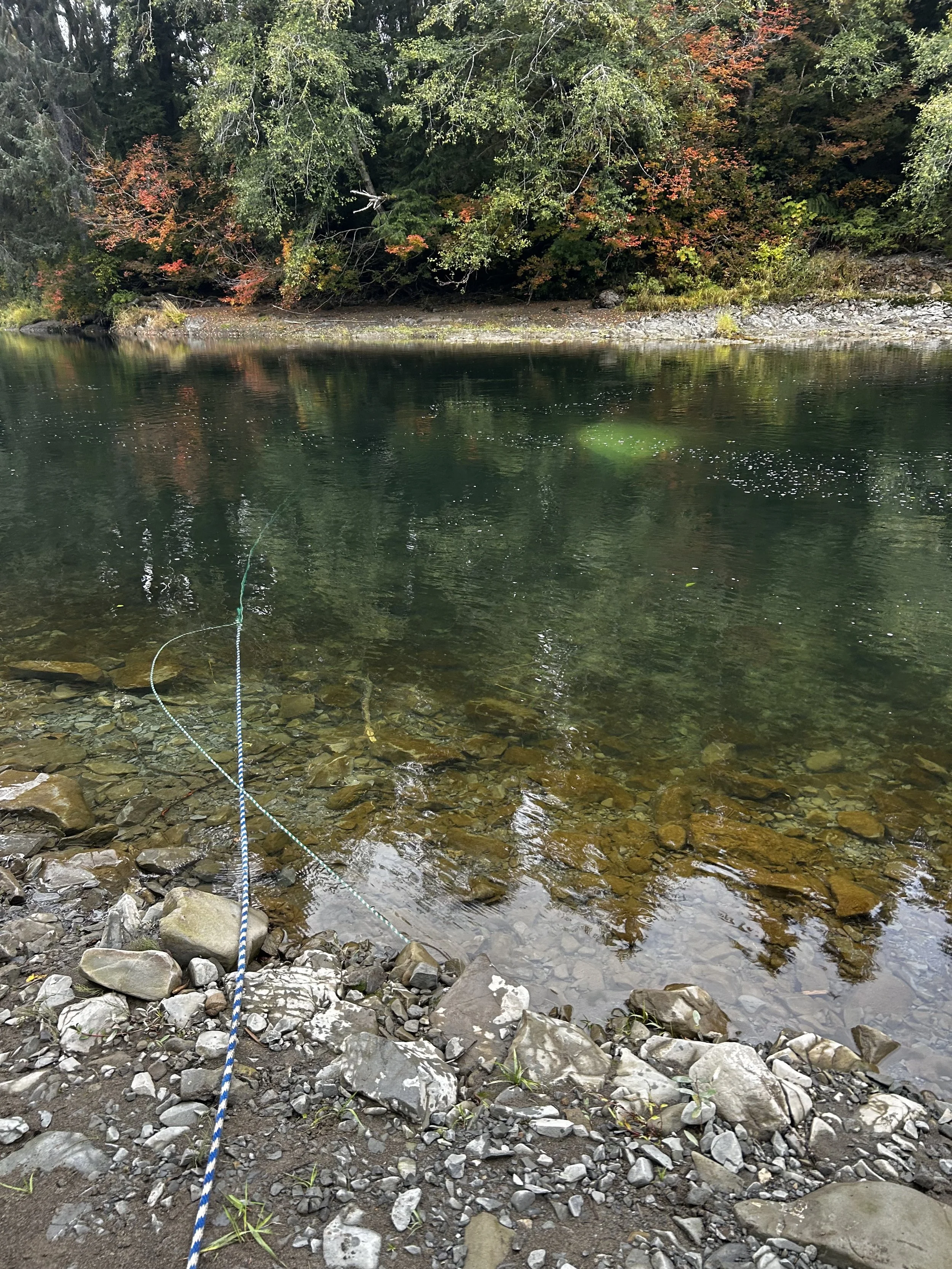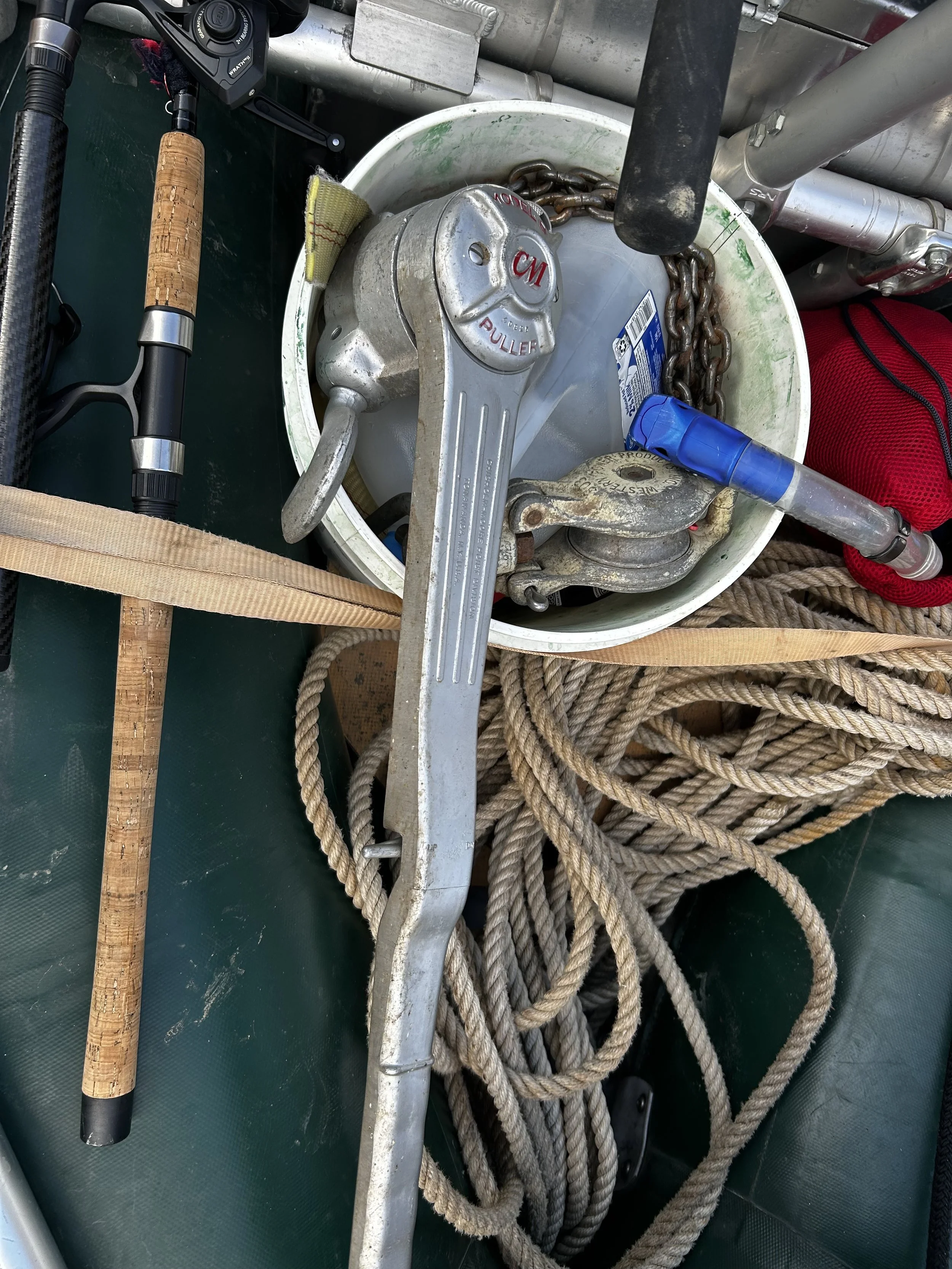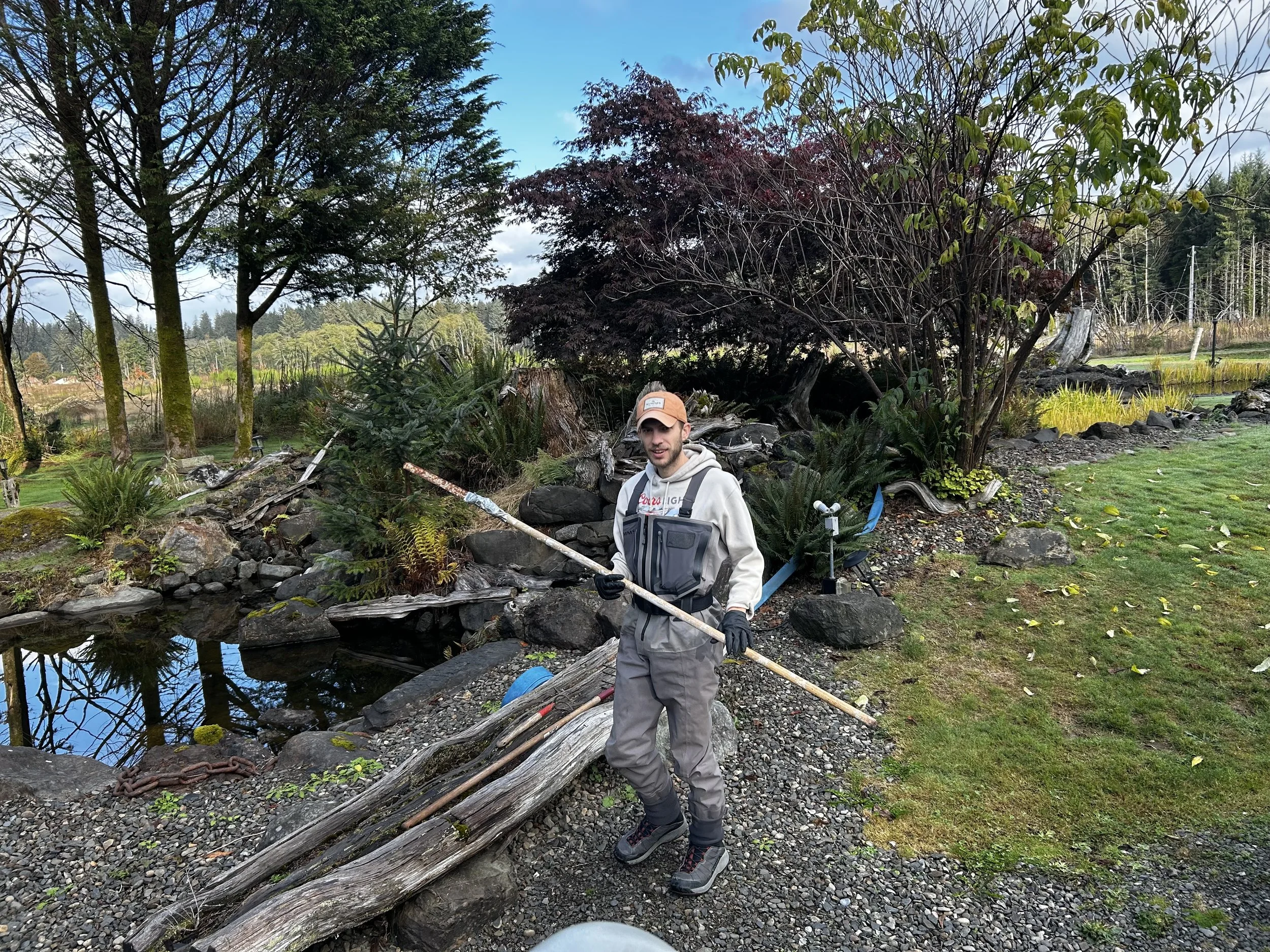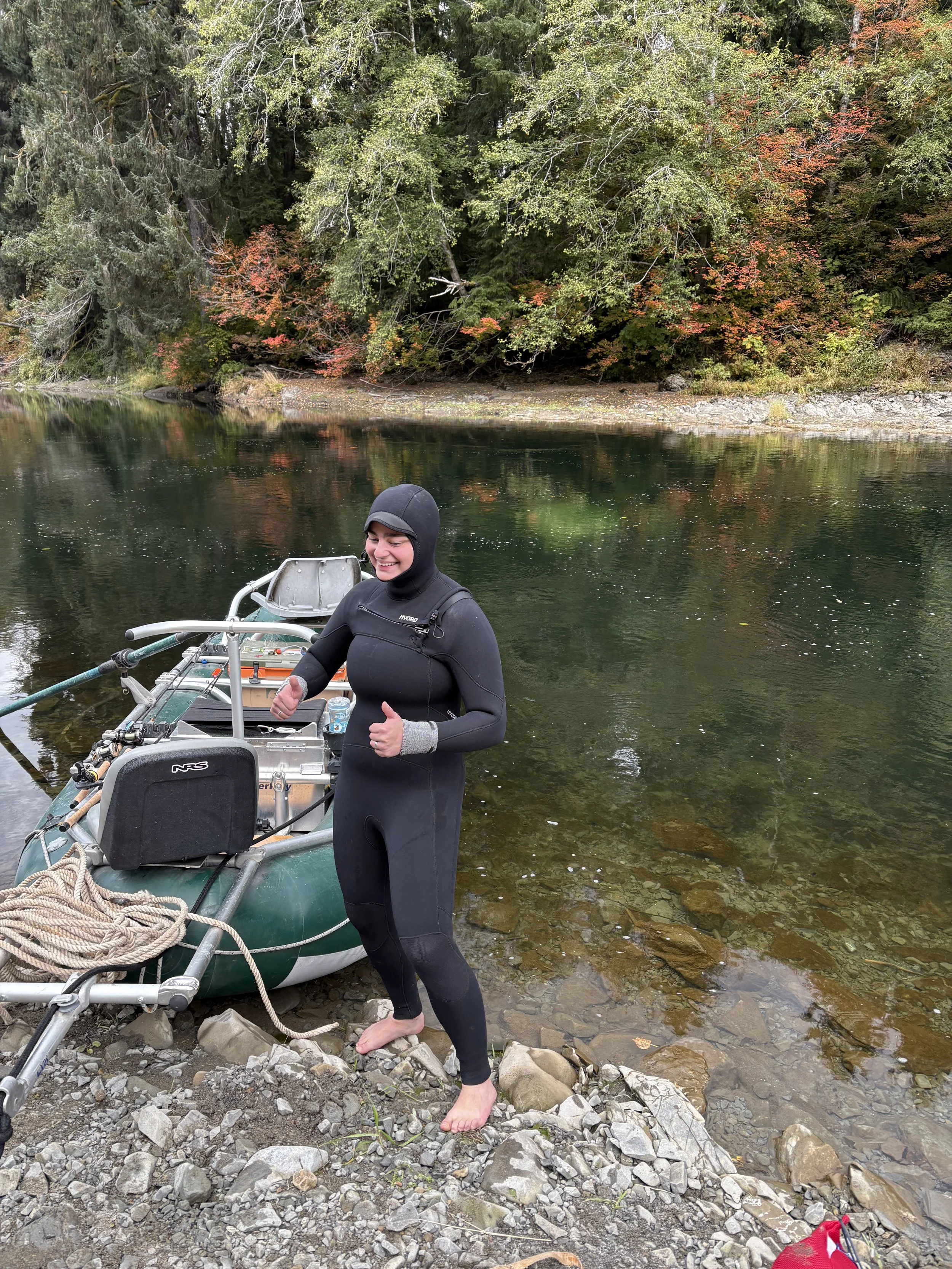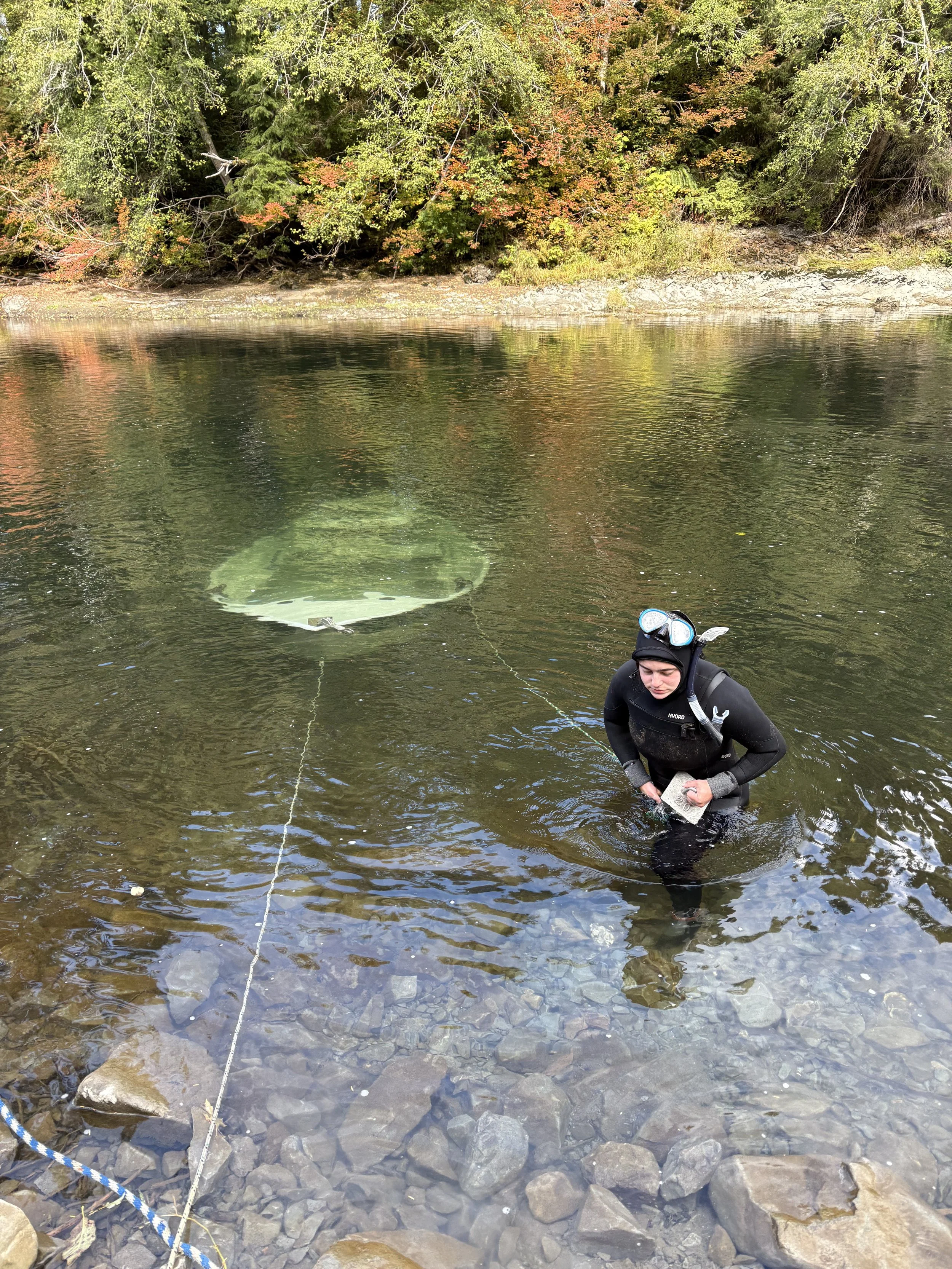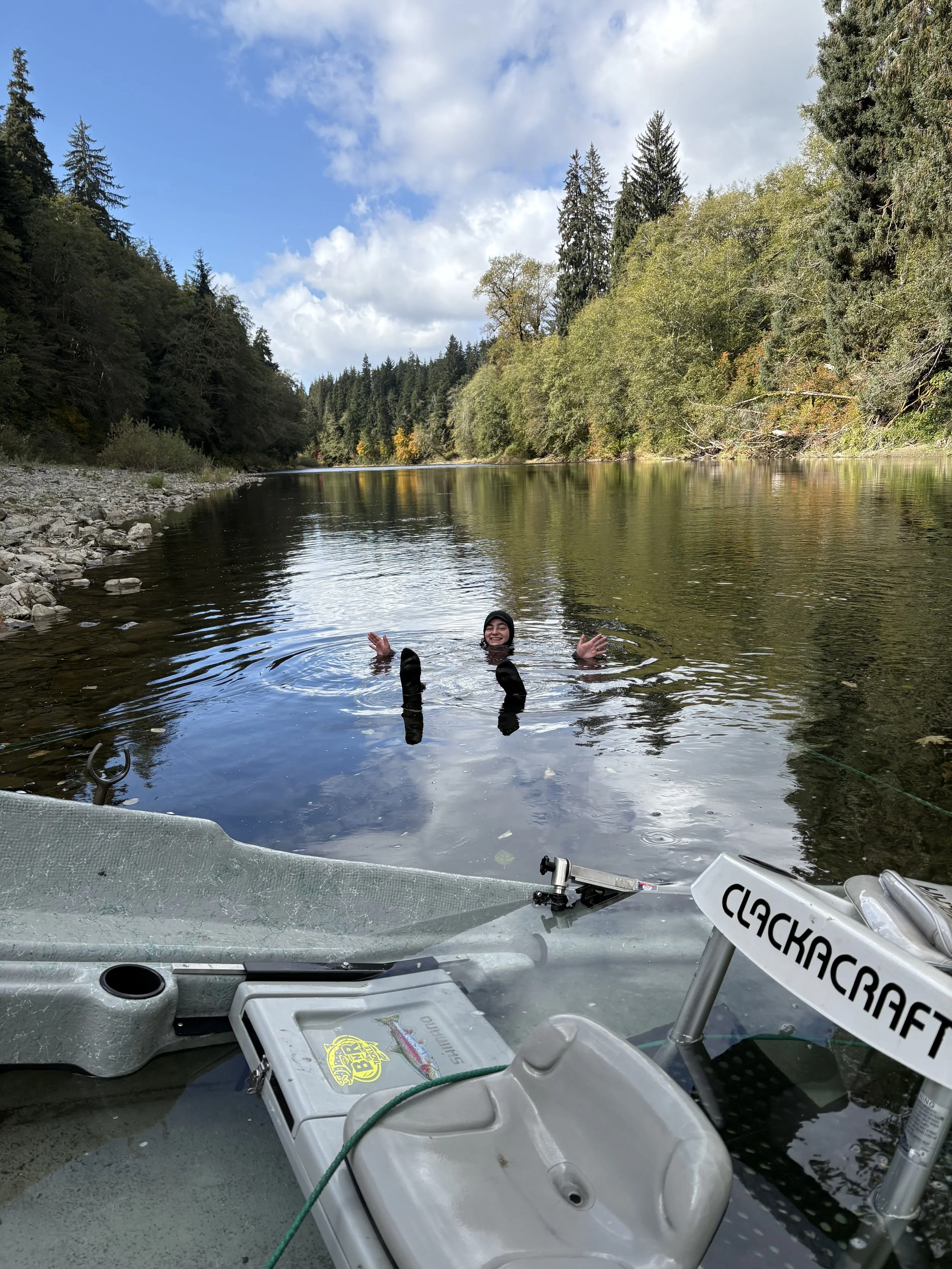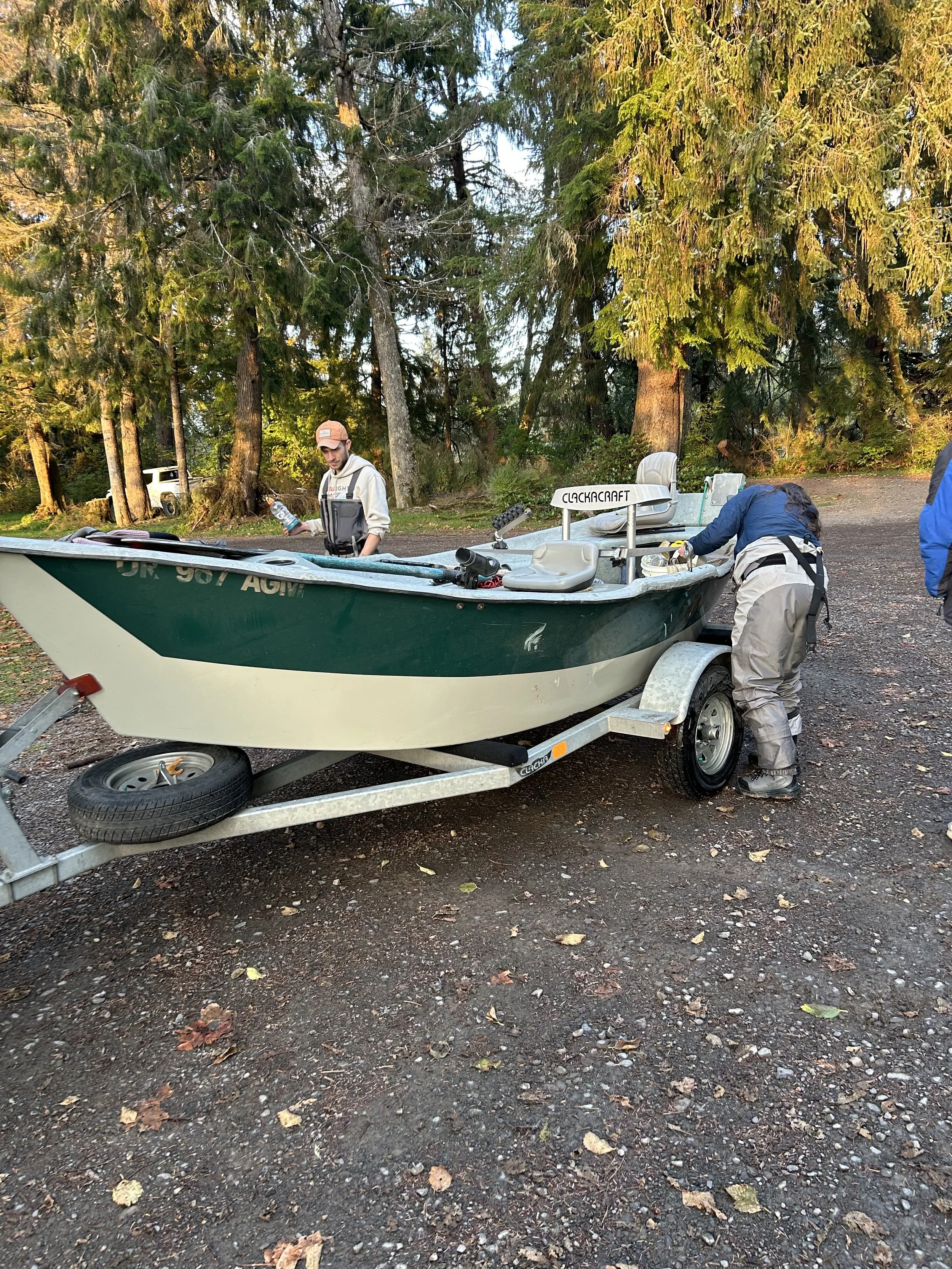Below the Icebox - Part II
Introduction
After sinking our Clackacraft drift boat just below the Icebox hole on the Bogachiel River, Teagan and I get to work on recovering our boat. With the help of our neighbors, our truckmover Lori, and our great friend and mentor Jeff, we make several attempts to recover the sunken boat.
October 5
As the icy blue of the early morning stretched across the sky, I sprang out of bed. Very little sleep that night, my brain just replayed the events of the day before over and over. How could I have done that? This was supposed to be the thing I was good at… I headed to the kitchen to get the coffee going, letting Teagan sleep a bit longer before we would put our waders on, gather rigging and ready the raft for its duties.
The night before, we spoke with Jeff a few times on the phone. He called us late at night, as we were stewing in our distress and sorrow. Somehow he knew the state that we were in. He made it clear we needed to go out and at least get eyes on the raft, and ideally put lines on it. Rain was forecast for later in the week, that was a Sunday, and by Thursday, rain was expected, which could make things trickier. We were on a timer. We would have to head back to Seattle the next day, and we had to utilize the tractor we had on rental to clear the fields and various problem areas on our property. We needed to make something happen that day.
Coffee in hand, waders on, rigging in the raft, we headed out down the driveway and turned right onto US-101.
"Let’s go get this fucking boat” I said.
We arrived right back at the hatchery launch, with no other rigs there this time, and texted Lori (our trusty truck mover) to inform her of our plans. Green raft was in the water, loaded with everything but fishing equipment. We made good time to the Icebox hole and anchored our raft on the left bank, well away from the downed tree, just above the rapid. We marched down the bank, around the rapid and began scanning the water to see what we could find. Nothing…nothing….nothing….nothing….Disheartened, we walked back up to the raft, and began walking it down the far left of the riffle, thoroughly uninterested in trying to row that rapid a day after the catastrophe. Once down the water we didn’t want to row, we hopped into the boat and began rowing around the hole, both craning our necks to see if there was any sign at all of the boat. We rowed around the hole for quite a while, focusing on the slow water, the pool that held a deep pocket of water after the rapid where two large shelf rocks dwelled. We both came to the depressing realization that the pool may be too deep to spot the boat if it was indeed at the bottom….
After more searching, and more fruitless effort, we kept moving with the hope that it had somehow made it past the deep, slow pool, down the next shallow riffle (somehow??) and into the next deep holding water…but to no avail. There was no sign of it. This ushered in immeasurable frustration, pain, and negative self-talk. Soon, the mood, which had been relatively chipper earlier that morning before arriving to the seemingly empty crash site, had soured to the lowest point I can remember between the two of us. Neither of us spoke, whatever words I did utter were words of hate directed towards myself for putting us into the situation. We arrived at the launch only a couple hours after we put in, and Lori had not yet arrived, so we stewed at the launch for a couple hours. Sitting in the raft, staring at the calm water flowing by, I let my brain go to dark places. Looking back on it now, knowing what I know, I need to be better the next time this happens. I need to avoid such self talk and stay positive.
Eventually, Lori rumbled into the launch with my truck and hopped out. This was the first time that we had ever actually met after countless floats, and she could instantly tell something was wrong. I told her about the boat and she gave me a great big hug. I never needed a hug so badly. The kindness of Lori in this moment played a big part in keeping my spirits high. She helped me realize we were certainly not alone in our endeavors.
We headed back to get as much use out of the tractor as we could before darkness fell. Before bed though, we had a chance to check in with Jeff and set a plan of attack moving forward…We would return the next weekend and try again, and in the meantime, Jeff would see if he could rally anyone to help recover it.
October 10
That week was a tough one. I spent almost every minute of it thinking about my mistakes that led the boat right into that damn tree. As each morning came, I really could not believe that I had done it. I knew the only way to recover mentally was to get that boat out. That Friday, we were able to begin resuming our rescue efforts again. We loaded our vehicles up and each headed out to our house on the Peninsula, me in the truck, Teagan in her car.
A few months ago my parents had arranged to come out an visit the house, and were due in at around 6pm that day, right around when we would be arriving as well. That night, we unloaded our vehicles, got some food from Sully’s and listened to Game 5 Mariners vs White Sox on the radio…it was a wild game that went something like 15 innings. It helped take my mind off of the anticipation for the next day’s endeavors that had been eating away at me all week. The plan was set though: Teagan, my dad, and I would set out on the raft the next morning with as much gear as we could bring to get eyes on the boat. We would also bring some rods to see if we could get into any fish along the way.
October 11
Next morning, we took our time, loaded everything up into the raft, suited up into our waders, piled into the truck, and headed for the hatchery launch. Weather was gray, overcast, and brisk. Soon our truck was crunching over the stoney bank of the launch, dipping the raft trailer into the low clear water of the Bogey. The river had dropped notably since the last week, which was exceptionally lucky…With my dad in the back, and Teagan in the front, we were off.
The raft was perhaps the most encumbered it had ever been with the three of us and all of the rigging and tools we brought for the recovery effort. In the low water, we were quite sluggish. Rocks and stones that would usually go unnoticed by our raft were grabbing and clawing at it. We took our time, making sure to cover the fishy water between us and the Icebox. We twitched jigs, threw spinners and my dad even dogged some bobber. At one point, I switched with Teagan in section of particularly slow water so that I could twitch some jigs before we arrived at the rapid. After several casts with a 1/2 oz pink and orange, fire bright twitcher, I hooked into a nice beefy fish that shook me after two shakes. Casted again, and boom. Hammered another on the twitcher in the same hole. This one had some real spunk. He gave me three or four really nice runs, peeling line, jumping, bull doggin and all. Teagan rowed us to shore and I fought him on the bank for a good few minutes. We were able to tire him out and get him in the net. He was a really beautiful chrome buck. Had a great big adipose on him. The wild fish out there really are in a class of their own, especially when compared to the fish that return to the Sound. They are specimens, truly.
After releasing him safely (he bled a little bit, but after a short while the bleeding settled down and he sparked off with great energy), we piled back into the raft and headed for the Icebox. After a while back rowing to speed us there, we pulled off to the far left above that fateful Tree. We anchored up, and I began helping my dad to the shore, as there was quite a long stretch of shallow, slippery stones that could be deadly to anyone given a misstep. After a while of steady and careful walking, I felt we had gotten to steady, dry ground and I could leave him with this wading stick (our landing net) to navigate the rest alone while I ran down stream to check if I could see any trace of the boat.
My heart started to pound hard as I carefully billy goated over the rocks, choosing each quick step with care. As I made my way around the bend, along the bank, I began scanning the water that I thought my be holding our boat. The top of the section (just below the Tree) was too fast to be holding it, though it was impossible to rule it out for sure. The next short stretch was fast, with a couple big boulders breaking the surface, and also held water that could hold the boat, but also seemed unlikely due to the speed. The section after that was deeper and slower, marked by two very large shelf rocks that indicated some serious depth, perhaps surpassing 20ft. The last section was slightly less deep and even slower, and we were hopeful that the boat would be there, stuck up somehow on the bottom…and it was! After skipping along the bank for a few strides I could see the unmistakable white glow of the bottom of the Clacka. It was completely still, resting below the surface of the water like a mummy in a tomb.
“I found it! I found it!” I yelled. “It’s here! We can get it, we can get it!”
I turned immediately and kept yelling and yelling hoping Teagan and my dad would hear. I ran back up, past my dad who was still making his way down, and up to Teagan who was standing with the anchored raft. They both started cheering as I yelled the incredible news. As I reached Teagan, we prepared to line the raft around the Tree and down the rapid, just so we wouldn’t have to deal with the rapid and the exceptionally low water levels. We readied our lines, and followed our normal protocol for such an operation. One bow line, one stern line, each with plenty of slack should we need it. Once down and around, we found my dad, and anchored the raft up.
My dad was looking at the sunken boat resting peacefully in the middle of the river. From where we were it was quite diffucult to tell just how deep the boat was. It could be just beneath the surface for all I could tell, so Teagan and I hopped into the raft to get a closer look. The water in this section was so slow, we could navigate around easily to perform our investigation…and soon we discovered it was fairly deep, maybe 10-12 feet deep. The initial excitement of laying eyes on the Clacka had worn off a bit, but was replaced with adrenaline. I knew we just needed to grind now. If we could just get a line on it, we had a chance.
And so it began.
The first approach we tried was to drag a metal hook along the river floor that we had attached to a long strap. This strap could ultimately be fed into a ratchet system to offer us more pulling power, we just needed to hook some part of the boat. We took passes over the boat for a while, maybe 30 minutes or so, getting acquainted with how the current would belly the strap, making it difficult to tell where the hook was. Then on one pass, I noticed my strokes were met with intense resistance all of a sudden. We had hooked some part of the boat. I really couldn’t believe it. I craned my neck around the raft trying to get a glimpse of what it was that we hooked exactly. Oddly enough, I saw one of the boat seat eerily gliding towards us as Teagan pulled on the strap. The seat was wrapped around both the front and rear anchor lines, which our hook had latched onto. We were connected to the boat. We had an avenue to success.
Now the question was: could we pull this thing out, just the three of us…We tried for hours, pulling at different angles, using different systems but to no avail. In one sequence, we did actually pivot the boat 90 degrees, but as we would uncover later it ended up getting more stuck. The oarlock got caught on the river floor and no matter how hard we pulled or at what angle, the boat would not budge. It was beginning to get dark and mom was starting to worry, so we packed up and headed downriver. We were feeling pretty confident about our odds of getting this boat back home the next day.
Teagan cooked up a nice pasta meal at home, stories were had and beer was drunk in preparation for the next day. We spoke with Jeff and our neighbors to game plan more options we could consider. We really did need to get the Clacka back the next day, as Teagan needed to head back to Seattle that same day for work, and Teagan’s presence would be absolutely crucial in retrieving it.
October 12
This was the day. We needed to come prepared and we needed to execute. We brought all sorts of tools with us on the raft that Sunday. Our neighbor Rene lent us a pulley, rope, and a most importantly, a chain winch. We rented a wetsuit and brought our diving goggles and snorkel, a weight belt, dry clothes, and a towel. Jeff rigged up a long stick with a serrated blade on the end, to which we attached two more poles, ultimately crafting a 15 foot lance. This time, it was just Teagan and I with all the gear. We did not really fish this time down to the site, as we were eager to give ourselves as much time as possible to attempt the recovery.
Chain winch, pulley and rigging
We added another two sections to this “stick and knife”
Our first attempt was to try to use the lance we got from Jeff to see if we could cut the anchor line, but we quickly realized this would be futile. Then, Teagan and I both came to the conclusion that she would need to put the wetsuit on, dive down and make something happen. What that something would be, we were unsure of at the time, but we settled on getting a line on the front D ring. Our thinking was that if we could get a line on a part of the boat that is meant to be pulled, we may give ourselves a good chance of freeing the boat from the clutches of the river floor.
Teagan is the better swimmer and the better diver, so she would be the one to suit up. Luckily, the wetsuit we rented for 20 bucks was a pretty good one. It was thick and had a hood, which would almost surely protect Teagan from the icy temperatures of the water. After wiggling and squeezing into the tight fitting wetsuit, slipping on water socks, sliding on diving gloves and cinching the weightbelt around her waist, Teagan was ready to go. She grabbed the line she would bring to hook onto the D ring, and began to walk out to the boat. It was not too far off the bank, maybe about 15 feet. The D ring was the closest part of the boat to us at that point, which was also lucky.
Smile on her face before she descends!
On the first dive, Teagan duck dove, making a big splash as she descended. The water on the surface soon became still again and I was left standing there, helpless and hoping. Then Teagan burst out of the water, shattering the relatively still surface. She reported that she had lost the weightbelt, and had been unable to attach the line to the D ring. Devastated, I tried to assess her mental state. I did not want her going back under if she was uncomfortable in any way…but I had a feeling she would take these circumstances personally and want to avenge herself. I was right, she took her time recovering her breath, steadying her emotions and chose another approach. She duck dove again, and again horrible silence and stillness topside. But down below, she hooked it. She got the line on the D ring, and burst up yelling:
“Got it!”
I was elated. We had a chance now. Doors had been opened because of Teagan’s courage and willpower. We got the line hooked up to the chain winch (via Teagan’s extensive knot knowledge) and began cranking. Within a few cranks, we heard it and felt it. Something shifted, but we weren’t sure what. There was a chance that this approach could result in ripping the fiberglass hull of the boat if the leverage was just right (rather, just wrong), but thankfully, that is not (entirely) what happened here. The boat had turned and risen off the bottom! Instead of laying in it’s turtled form in the depths, it had seriously shifted after only a few cranks.
Now we really knew it was possible. We got up to assess the boat given this new perspective. The inside looked solid and relatively unharmed. We knew we just needed to keep cranking. So we hustled back to our posts and began cranking, until the winch was fulled cranked and needed to be reset. For this approach to work, we would need to tie two lines to the boat. This way, when. our winch was cranked to capacity and needed a reset, we could tie the line with tension to the line connected to the tree with a third line, so that tension and progress were not lost every time we needed to reset the winch.
We repeated this process maybe 20 times or so over two hours. Cranking , tying, resetting, tying, cranking, etc. Finally, the bow broke the surface. Then the oarlocks broke the surface. Then the stern, and soon the whole boat was out of the water and we just needed to bail. The bailing process was relatively quick and before I knew it, I was in the rowers seat with our spare oars ready to row the Clacka home.
We cleaned up our basecamp on the riverbank, coiled our ropes and loaded everything into the two boats. Even though one of the oar locks was destroyed and unable to fit an oar, I was still able to row it decently well, pressing (or pulling) against the bent oar lock for leverage. The stretch of water after that rapid is quite trivial, but I learned my lesson. No water is to be taken lightly again and the safest line must always be assessed and executed. Even the riffles were daunting to me now, and it felt as if I were starting rowing entirely from scratch.
Before long, we made it to the launch where we loaded the raft onto the trailer. I drove the raft home, switched trailers and headed back to Teagan who was waiting with the rescued boat at the launch. I backed the empty trailer down the steep ramp at Wilson’s reuniting the Clacka with it’s trailer. It was atruly glorious feeling pulling that boat out of the water, the way it should have been 8 days prior, but never was.
As I write this on October 19th, a day after dropping the boat off for minor repairs and even some improvements in Oregon, I still am having a hard time processing the events told in this post and the previous one. We were so lucky to survive that event. We learned many invaluable lessons that others may have not been fortunate enough to survive to practice. I learned that even at the lowest of lows, I will not quit rowing and fishing. I will not stop exploring and interacting with these capitally important rivers. I will wear my freaking life jacket, and those in my boat will do the same. I will not underestimate the structural integrity of a Clackacraft floor. I will wear my wading belt tight, and so will those in my boat. I have the coolest fiance in the world. The fact that she dove 10 feet down in the Bogachiel River in October to hook a line onto a sunken drift boat that ultimately leads to its recovery is a feat that very few, if any ever accomplish.
These events really just hammer home the idea that these rivers are not to be taken lightly. Ever. They demand our entire attention and respect. Teagan and myself will never forget that, as we very nearly were taught a mortal lesson by the Bogachiel River.
Why don’t you stub your toe anymore? Because you stubbed ‘em all the time as a kid and learned to pick your damn feet up
-Jeff Woodward

